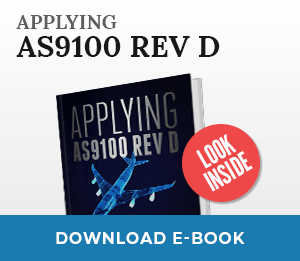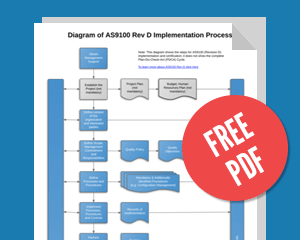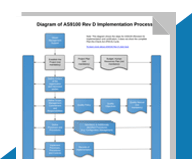With the release of AS9100 Rev D in September 2016, the requirement to have a quality manual for your aerospace Quality Management System (QMS) has been removed from the standard, but do you really want to remove this document from your system? While it is still possible to have a fully compliant AS9100 QMS without a quality manual, here are a few things to consider before you decide to make this document obsolete and remove it from your system.
Where will you keep small pieces of required documented information?
There are many pieces of information that AS9100 Rev D requires you to have as documented information, so you do need to keep them somewhere. This information includes your QMS scope, Quality Policy, definition of QMS processes and interactions, QMS roles and authorities, and many other pieces of QMS planning and definition information that need to be documented and maintained. So, the question is: If you don’t want to use a quality manual, how will you document these pieces of information? How will you keep this information controlled and updated as necessary? These are questions you will need to think about and address if you are deciding to remove the quality manual from your documentation.
AS9100 Rev D recognizes the benefit of having a quality manual
In fact, the AS9100 document still makes reference to a quality manual in a note in section 4.4.2 about documented information. After identifying many things that need to be included as documented information for an aerospace QMS, such as the description of interested parties and processes and interactions, the standard includes a note that states that the QSM description defined can be compiled into a single source of documented information and referred to as a quality manual. In this way, the authors of the AS9100 standard have acknowledged that many companies have a quality manual that is useful to them, and there is no need to eliminate it.
If used right, the quality manual can be a sales tool
For companies that have created a quality manual, with useful information that defines their company and addresses what customers need to know, these companies will already know that a good quality manual can be used as a way to address customer concerns when attempting their first sale. If a customer needs to understand how your organization and the Quality Management System work to address customer needs and attain customer satisfaction, and this is included in your quality manual, then this one document can easily address these concerns.
Additionally, many customers want to know that you have implemented certain processes within your organization, such as processes for nonconforming products or corrective actions, and if your process descriptions and interactions are in your quality manual, you have a quick and simple way to address this customer need. Including your process descriptions and interactions within your quality manual is an easy way to document, maintain, and control the update of this vital information.
Make your quality manual useful for you
One of the benefits of the quality manual being removed as a requirement from the AS9100 Rev D requirements is that you now have the freedom to use this document as a tool to benefit your company however you see fit. For instance, if you have exclusions to the AS9100 requirements, these used to be required in your quality manual, but now if you prefer to maintain this information elsewhere and not share it with the interested parties who will see your quality manual, this is up to you.
That being said, the transition of your QMS to the AS9100 Rev D requirements is a perfect time to rethink the quality manual within your organization, especially if you have a quality manual that is just a restatement of the AS9100 requirements, as some companies do. Some things to consider are: what do you want your quality manual to do for you? Which interested parties will you share your quality manual with? What needs to be included to make your quality manual useful for your organization and your interested parties? Updating your quality manual to be more useful for you can help your QMS in the long run.
The quality manual needs to be an improvement
With the transition to AS9100 Rev D, you really need to think about your quality manual and what it does for your Quality Management System. If you are to keep a quality manual, it needs to provide a benefit for your company. It is no longer a requirement, so make sure it provides a benefit by relaying the information you need to relay to the people you need to relay the information to. Don’t keep your quality manual simply because someone told you that you should – make it count.
If you are looking for more information on implementing AS9100 Rev D within your organization, see this article on 13 Implementation steps for AS9100 Rev D.

 Mark Hammar
Mark Hammar 


